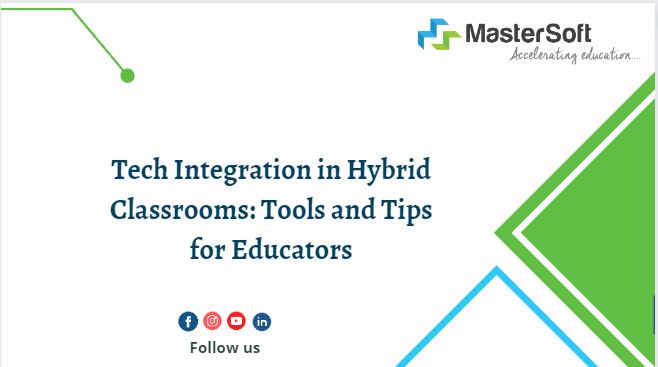
Tech Integration in Hybrid Classrooms: Tools and Tips for Educators
A dynamic educational strategy that blends classroom and online training has evolved termed hybrid learning. With this strategy, students can participate in both in-person classes and online courses, giving them flexibility. Teachers must adjust to the needs of Hybrid Learning as the educational landscape changes, utilizing technology to enhance cognitive learning. In this article, we explore the resources and advice that teachers may use to seamlessly integrate technology into hybrid classrooms.
Technology Integration Resources For Hybrid Learning
-
Learning Management Systems (LMS)
LMS platforms act as the focal points for communication, assignments, and course materials. They give students access to materials, places for collaboration, and evaluation equipment.
-
Tools for video conferencing
Active involvement is encouraged via concurrent virtual courses and conversations made possible by platforms like Zoom and Microsoft Teams.
-
Interactive Whiteboards
Using digital whiteboards, educators may graphically convey ideas to students, increasing knowledge and engagement.
-
Educational Applications And Software
From virtual laboratories to interactive quizzes, different apps meet a range of learning requirements.
-
Document Collaboration And Sharing Tools
Google Workspace and Microsoft Office 365 provide real-time document and project collaboration.
-
Electronic Books And Online Libraries
Digital resources offer simple access to a wide variety of content.
-
Contact Channels
Reliable contact between teachers and students is ensured via platforms like Slack or WhatsApp.
-
Virtual Reality And Augmented Reality
These are immersive learning tools that make teachings more real-world.
-
Online Assessment Tools
Quizlet and Kahoot are examples of platforms that make tests more interactive and interesting.
How To Successfully Integrate Technology In Hybrid Learning
-
Determine Your Technological Needs
Consider your classroom’s needs and select resources that support your educational objectives.
-
Give Clear Instructions
Students who get clear instructions are more likely to comprehend how to use and navigate technology.
-
Provide Training And Support
Hold training sessions or distribute materials to aid in the tool proficiency of students and other instructors.
-
Encourage Student Engagement
Use interactive tools to promote cognitive learning and active engagement.
-
Combine Synchronous And Asynchronous Activities
For a well-rounded learning experience, combine live sessions with pre-recorded information.
-
Prioritize Accessibility
Make sure all students can utilize the technology and access it while taking into account their various learning requirements.
-
Establish A Collaborative Setting
Utilize technologies that encourage peer collaboration, group projects, and conversations.
-
Utilize Data For Improvement
Examine data from tech tools to pinpoint places in need of improvement and specialized assistance.
-
Promote Continued Exploration
Introduce new tools and promote experimentation to promote a culture of inquiry.
The Benefit Of Cognitive Learning In Hybrid Learning
Effective education is based on cognitive learning, which emphasizes mental activities including problem-solving, critical thinking, and knowledge retention. Several ways that tech integration in hybrid classrooms might improve cognitive learning include:
-
Interactive Educational Opportunities
With the use of technology, instructors may produce engaging simulations, tests, and situations that push students’ capacity for critical thought.
-
Paths For Personalized Learning
Tech-enabled learning environments may be tailored to students’ strengths and limitations by analyzing their learning habits.
-
Applications In The Real World
Virtual labs and simulations offer students a secure setting in which to explore and learn from their errors.
-
Online Collaboration Tools
It allow students to collaborate on challenging assignments, improving their problem-solving abilities.
-
Instant Feedback
Tech tools provide immediate feedback, enabling students to quickly spot and correct errors.
-
Gamification
By involving students in challenges and rewards, gamified learning experiences encourage the growth of their cognitive abilities.
-
Data-Driven Education
Examine student performance information to personalize education and interventions for each student.
-
Active Participation
Online chats, polls, and quizzes enable students to actively participate in the subject matter.
A Catalyst For Future-Ready Skills: Hybrid Learning
Hybrid classrooms are essential for educating kids for the future as technology is increasingly incorporated into education. The competencies gained in hybrid learning environments meet the needs of the contemporary workforce.
-
Digital Literacy
the ability to use a variety of tech tools proficiently, which is essential in the modern world.
-
Online Collaboration
It helps people improve their writing and vocal communication abilities.
-
Critical Analysis
Critical thinking skills are improved through examining facts and solving challenging situations.
-
Adaptability
Flexible learning environments and technologies are fostered by hybrid learning.
-
Time Management
Effective time management skills are necessary to balance in-person and online study.
-
Personalized Learning
Students are encouraged to take control of their learning process via the use of technology.
-
Worldwide Connections
Students are better prepared for a global workforce through virtual cooperation.
Conclusion
Technology integration in hybrid classrooms has a huge potential to improve cognitive learning and better prepare students for the future. Educators may design effective learning experiences by utilizing resources like virtual reality and LMS systems. Successful digital integration may be attained by adopting strategies including providing training, encouraging involvement, and emphasizing accessibility. Hybrid learnings outfitted with cutting-edge tech tools are positioned to cultivate future-ready abilities, enabling kids to flourish in a dynamic environment as the educational landscape continues to change.



